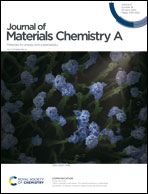On stability and kinetics of Li-rich transition metal oxides and oxyfluorides†
Abstract
Apart from high capacity and high energy density, fast kinetics and thus low barriers for lithium diffusion are essential for the functioning of Li-ion batteries. Recent studies have shown that disordered rock salt (DRS) compounds can meet these requirements, which is surprising as disordered materials typically are assumed to exhibit low ion mobility. In our computational study, we investigate the structural stability as well as the diffusion kinetics of Li-rich transition metal (TM) oxides and oxyfluorides with a special focus on vanadium- and titanium-based compounds. By investigating different model systems, we move from α-layered LiTMO2 type compounds to the disordered rock salt structures of Li-rich Li2TMO3 and Li2TMO2F, proving that the DRS oxides can only be stabilized by Li-excess. High fluorine contents, on the other hand, are found to call for a certain degree of ordering to avoid unfavorable TM–F bonds. In Li-rich DRS phases, we find that diffusion barriers may, in spite of having the same local environment, differ strongly, consequently pointing towards important factors beyond the so-called gate site configuration. Moreover, the substitution of oxygen by fluorine in DRS-type structures is observed to have a rather negative impact on the kinetics, in contrast to expectations from oxidation state arguments. The diffusion barriers in DRS-type materials turn out to be non-trivial quantities that are determined by the exact configuration, extending beyond the gate site occupancy.



 Please wait while we load your content...
Please wait while we load your content...